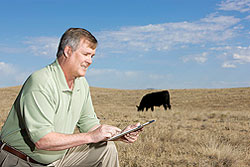Ranchers in the central Great Plains may be using some of their winter downtime in the future to rehearse the upcoming production season, all from the warmth of their homes, according to U.S. Department of Agriculture (USDA) soil scientists.
 The ranchers would use the GPFARM (Great Plains Framework for Agricultural Resource Management)-Range computer model to see which cattle or sheep stocking rate scenarios are sustainable. USDA’s Agricultural Research Service (ARS) soil scientists are testing the model in enough locations to get the model fully usable throughout the central Great Plains.
The ranchers would use the GPFARM (Great Plains Framework for Agricultural Resource Management)-Range computer model to see which cattle or sheep stocking rate scenarios are sustainable. USDA’s Agricultural Research Service (ARS) soil scientists are testing the model in enough locations to get the model fully usable throughout the central Great Plains.
The model would allow ranchers to test various scenarios involving forage yields and the weight gains of beef cattle and calves and other livestock under various stocking and weather scenarios. The high variability of precipitation makes it difficult to choose a stocking rate that is the best balance between economic and rangeland sustainability. Looking at National Weather Service seasonal weather predictions, ranchers would judge whether precipitation in the coming season would likely be normal or above or below normal.
GPFARM-Range is one of a few range models that can factor in the effects of climate change on stocking rates, predicting the response of forage plants to increased carbon dioxide and higher temperatures.
